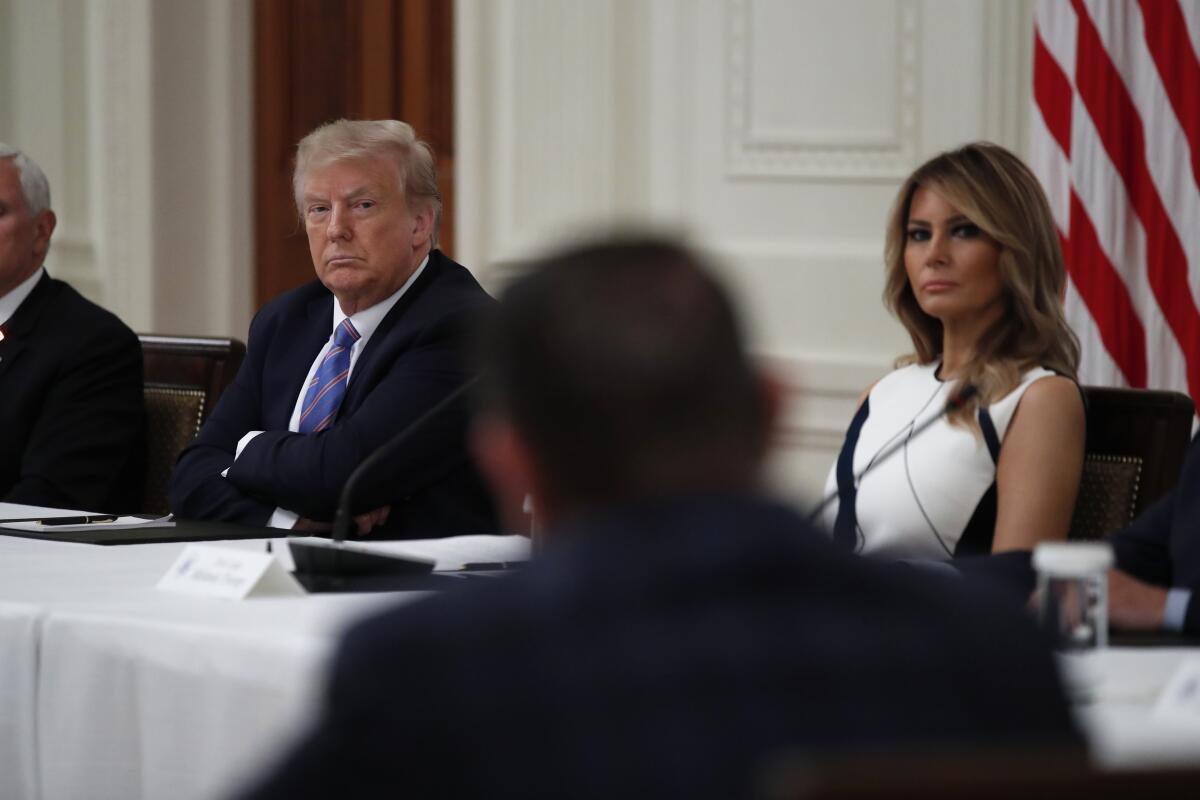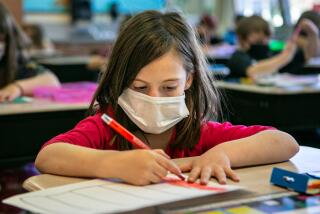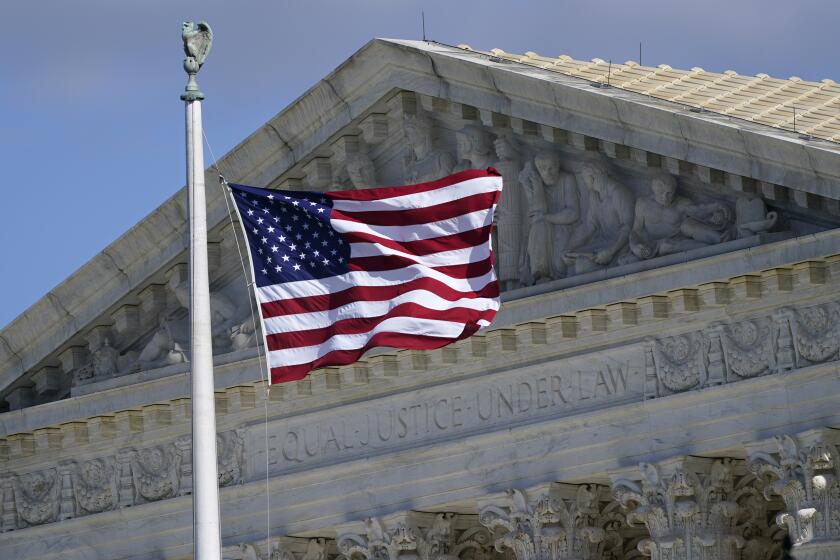Trump urges K-12 schools to reopen. Others aren’t so sure

- Share via
WASHINGTON — President Trump on Tuesday urged the nation’s public schools to reopen “quickly and beautifully” and jabbed at districts like Los Angeles’ that remain uncertain, again injecting politics into the pandemic response.
As the nation’s death toll from COVID-19 surged past 130,000 this week, cases are rising in 38 states, including an outbreak at childcare facilities in Texas. Teachers are anxious. Parents are confused and divided. And public health experts worry that local officials nationwide haven’t spent the time and money to copy the preliminary successes of some European countries that have sent students back to schools in recent weeks.
Federal officials say it can be done, while conceding the risk and the need to track new cases closely. The American Academy of Pediatrics has said it’s imperative for the health of children to give school re-openings a go, given the risk children face of abuse and social isolation at home, among other potential ills.
Yet even many of those urging a return to school worry that Trump’s diminished credibility on managing the virus’ spread makes him ill-suited to lead the kind of debate on balancing competing concerns.
“The president has made himself beyond irrelevant on this, and no one can afford to listen to him because what he has done already is so dangerous and has cost so many lives,” said Arne S. Duncan, who served as secretary of education under President Obama and was the former superintendent of Chicago Public Schools.
Trump, increasingly desperate to revive the economy ahead of November’s election, claimed during a White House roundtable on the subject that school officials who don’t quickly re-open classrooms would be acting in their political self-interest.
“They think it’s going to be good for them politically, so they keep the schools closed. No way,” Trump said. “So we’re very much going to put pressure on governors and everyone else to open the schools, to get them open. It’s very important.”
Afterward, six groups representing teachers, parents and school officials — including the two largest teachers unions — faulted the White House for offering “at best conflicting guidance for school reopening” and lacking “a comprehensive plan” that includes money for safety upgrades and equipment.
“No one wants students to safely return to classrooms more than parents, educators and administrators,” the statement said. “We also recognize that we must do it the safest way possible, not the most politically expedient way.”
Across the country, superintendents, principals, teachers, nonprofit groups and local elected officials have been working on plans and surveying parents during the prolonged pandemic. Many schools will be open in just weeks, but with a mix of in-person and virtual learning, staggered schedules with smaller groups of students attending classes on different days, new procedures for lunch distribution and physical education, and likely without extracurricular activities like school choirs.
“This has got to be done thoughtfully,” Dr. Jeffrey Koplan, a former director of the Centers for Disease Control and Prevention in Atlanta, said in an interview. “It’s not one-size-fits-all, and there will be some increased transmission in schools.”
Even as many infected children may not show symptoms, some do. “And we don’t know what the long-term health effects could be” even on those without severe symptoms, Koplan said.
The White House roundtable, one of several events to highlight Trump’s call to open schools, featured multiple panelists, including administration officials and supporters who praised the president — his education secretary, Betsy DeVos, even added the unrelated kudos, “Thanks to you, we’ve defeated ISIS.” While some attendees referred to precautions being taken by schools, there was little talk of ongoing risks, in keeping with Trump’s own minimization of the coronavirus’ toll.
Senior administration officials, speaking anonymously in a briefing with reporters, conceded that fully opening schools could lead to more infections but emphasized the lower threat to people younger than 30. They said damage could be mitigated if communities take steps to limit the spread and “double down in our commitment to protect the vulnerable.”
The advisors said Trump was not proposing to use federal funds to pressure local and state officials.
Los Angeles Supt. Austin Beutner said on Monday that no decision has been made about reopening campuses in the nation’s second-largest school system given ongoing safety concerns and the district’s inability to pay for and properly manage testing and follow-up contact tracing for the coronavirus.
California and Los Angeles County officials largely have left the issue of when and how to reopen classes to local school districts. The decision has been complicated by the state’s recent jump in infections.
Many families have indicated that they are not ready to allow their children to return. In a poll of parents, the L.A. district found that one in five were uncertain about their students returning. Another one in five were adamant that they would not send their children back.
Many L.A. school employees also expressed reservations: 20% were uncertain about returning and 36% were against it; 56% said they’d prefer to do their work “primarily from home.”
The issue is also tricky for Trump’s Democratic rival, former Vice President Joe Biden, given the apprehension from the teachers unions whose support is central to the Democratic Party. During a video conference with the National Education Association on Friday, Biden anticipated schools will use distance-learning “for a while longer,” and he echoed the union’s call for more money for safety measures.
Anita Cicero, deputy director at the Johns Hopkins Center for Health Security and a specialist in pandemic preparedness, in an interview said she worried that too many states are pushing ahead without waiting for caseloads to drop for 14 days, as the CDC initially recommended. While lower income families would benefit most from sending children to school — many parents work outside the home and depend on social services schools provide — they may be most at risk of an outbreak, Cicero said. Such families are more likely to have members with underlying health risks and less access to good healthcare.
“There should be a lot of discussion, knowing that there will be outbreaks — what should the triggers be to close them again?” she said.
In Florida, where Republican leaders have been aggressive about lifting pandemic limits, Education Commissioner Richard Corcoran on Monday ordered all schools to open five days a week, though the state has one of the biggest surges in illnesses.
“Our biggest concern is when we see places like Florida say schools are going to open five days a week, in total disregard of the safety issue,” Daniel A. Domenech, executive director of the American Association of School Administrators, said in an interview. The association has posted 40 pages of guidance for school systems on its website.
He estimated that additional expenses incurred by school districts — paying for masks, enhanced cleanings and additional busing to account for social-distancing requirements — will run nearly $500 per student, which adds up to $1.8 million for average-sized districts and as much as $100 million for major metropolitan districts like Los Angeles and New York City.
A fifth round of federal pandemic relief would likely include additional funding for schools, but officials question whether Congress will provide sufficient money, and soon enough to make a difference.
“The problem is we’re running out of time,” Domenech said. “We’re in to July, and schools will be opening up in a month. And if the money isn’t there, how in the world will schools and superintendents be able to open schools safely?”
More to Read
Get the L.A. Times Politics newsletter
Deeply reported insights into legislation, politics and policy from Sacramento, Washington and beyond. In your inbox three times per week.
You may occasionally receive promotional content from the Los Angeles Times.













